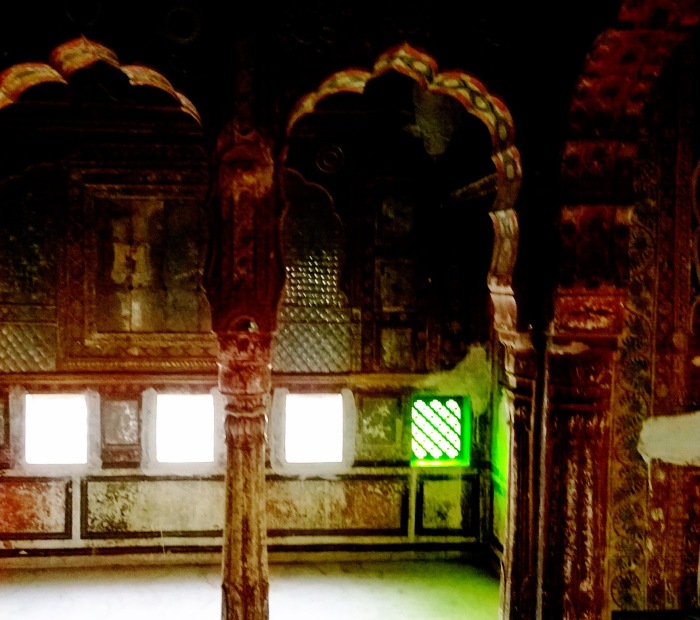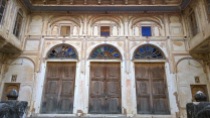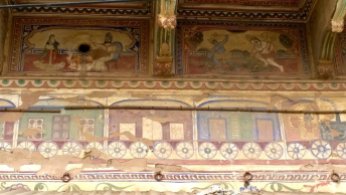Ilay Cooper’s book on Shekhawati set me off on an extraordinary trip to an extraordinary place in January this year. I had to wait for nearly 6 months before I felt ready to write about it — so overwhelming were my thoughts and emotions. This post on Mandawa is the fourth of 8 posts in the series on “The Painted Towns of Shekhawati”. If you haven’t read the introduction to Shekhawati’s history (and the series), I recommend that you do so now, before proceeding further. If you have already done so, then get ready to visit Mandawa. 🙂
Prior to my Shekhawati trip, Mandawa popped up everywhere that I looked around on the Internet. Whether it was looking for hotels to stay or making a list of havelis to see, or probable itineraries, or traveller tips and suggestions, or even blog posts — Mandawa was the Shekhawati town that featured prominently.
But historical records say that Mandawa wasn’t always like this. It used to be a sleepy, nondescript little village till it came under the rule of Nawal Singh, who inherited it. Yes, the same Nawal Singh who founded Nawalgarh. He laid the foundation for a fort in Mandawa in 1756 and also extended invitations to traders to settle down there. His grandsons, Padam Singh and Gyan Singh, moved to Mandawa at the end of the 18th century and continued with the work that Nawal Singh had started.
The 19th century saw Mandawa growing in size, economy and importance. Some of the prominent trader families in Mandawa were the Dhandhanias, Harlalkas, Ladias, Chokhanis, Sonthalias, Sarafs and the Goenkas. Mandawa became so prosperous that in 1828, the joint forces of Amer (Jaipur) and Sikar besieged it. However, the combined forces of Mandawa and Nawalgarh managed to hold out and the threat was overcome.
When I arrived at Mandawa from Dundlod at around 3.30 in the afternoon, it was to the fort that I headed towards.

 The oldest residential buildings in the Fort date back to the early 1800s and very little original paintings survive on the exterior walls. One look around the various buildings in the Fort and its is evident that the buildings have been built over a period of time and in various styles as well. From traditional Rajput-style architecture with Mughal influences to colonial style arches and columns — they are all there.
The oldest residential buildings in the Fort date back to the early 1800s and very little original paintings survive on the exterior walls. One look around the various buildings in the Fort and its is evident that the buildings have been built over a period of time and in various styles as well. From traditional Rajput-style architecture with Mughal influences to colonial style arches and columns — they are all there.
The Fort property is divided between two owners — one side is a hotel and the other is locked up with a desolate air about it. Since I’m not a resident of the hotel, I cannot go in and see the frescoes inside, and have to be content with what is visible on the outside, like the ones on the entrance arch.

 As I’m walking around the premises of the Fort and photographing its various features, a man comes up to me and introduces himself as the watchman-cum-caretaker of the locked portion of the Fort. He asks if I’d like to see something really spectacular — a chamber embellished with fine paintings and glass and mirror work.
As I’m walking around the premises of the Fort and photographing its various features, a man comes up to me and introduces himself as the watchman-cum-caretaker of the locked portion of the Fort. He asks if I’d like to see something really spectacular — a chamber embellished with fine paintings and glass and mirror work.
After some initial hesitation, I say yes and follow him inside through winding staircases and past locked and empty rooms before being finally led to the room in question.
 In the light streaming in though red and green coloured window panes, I can see finely detailed paintings on all the walls, pillars, niches and ceiling of the room. These are reflected multiple times in the mirrors placed strategically throughout the room. Some of the mirrors have gotten tarnished with age, but I can still see my reflection in some. Some of the paintings are in a bad shape, but some still have the details clearly visible like the Krishna Leela, Ramayana, and hidden in a niche behind a pillar a depiction of Balabhadra, Subhadra and Jagannatha. Looking back at the photos today, I wish there had been light to see the details in the room, and that my skills are low-light photography were better !
In the light streaming in though red and green coloured window panes, I can see finely detailed paintings on all the walls, pillars, niches and ceiling of the room. These are reflected multiple times in the mirrors placed strategically throughout the room. Some of the mirrors have gotten tarnished with age, but I can still see my reflection in some. Some of the paintings are in a bad shape, but some still have the details clearly visible like the Krishna Leela, Ramayana, and hidden in a niche behind a pillar a depiction of Balabhadra, Subhadra and Jagannatha. Looking back at the photos today, I wish there had been light to see the details in the room, and that my skills are low-light photography were better !
I also got a chance to climb up to the terrace of the haveli from where I saw the rather flat and monotonous landscape of Mandawa. Some large painted havelis could be seen and after making a general note of the direction they were in left to explore Mandawa town.

Wandering in Mandawa turned out to be quite a frustrating experience initially. Most of the havelis were shut or the watchman/caretaker missing from his post. This meant that, apart from the one in the Fort, I could not enter a single haveli in Mandawa.
Presenting a set of 42 photographs from the painted havelis of Mandawa. They cover religious themes, floral designs and verses. Clicking on any of the captioned photographs will start a slide show. Though you can start the slide show from any photograph, I recommend that you begin with the first, and once you have finished seeing the photos, don’t forget to come back to read the rest of the post.
I visited Mandawa twice, the second time in the hope of seeing the haveli interiors but I wasn’t lucky enough. Plus, it was raining the second time around and I didn’t relish walking around in the cold and navigating wet roads. After the initial frustration of not being able to see the haveli interiors, I started appreciating the unique design elements in Mandawa. The pastel colours, the trompe l’oeil effect of some of the frescoes, and the verses and chants painted on the building facades, which I didn’t see anywhere else in Shekhawati. The architecture too appeared more contemporary (relatively speaking that is !).
I didn’t find Mandawa to be a very friendly place. Yes, it is used to tourists and being a tourist hub for the region. But I don’t think Mandawa really likes them, especially Indian tourists. When I arrived at the Fort, I first had to get through a group of men all clamouring for my attention and offering to guide me through the various havelis in Mandawa. I might have taken up the services of one of them, but once they figured out that I was not an NRI, but an Indian they just lost interest and walked away. Every single one of them !
It makes me wonder why. Don’t Indians like to pay or are pay poorly or don’t appreciate the guides or the havelis? Or were the guides just men who were hanging around the Fort hoping to make some money from an unsuspecting tourist (NRI or foreign) and thought an Indian would know better?
Whatever the reason, I have decided to visit Mandawa again and attempt another try at seeing the interiors of the havelis after seeing this blog post. 🙂
Notes:
- Mandawa is just 30 km from Nawalgarh, my base in Shekhawati, and about an hour’s drive from there.
- Many of the havelis are locked up and empty. Some have just been abandoned, while some have caretakers who will allow you to see them for a small fee. For your own safety, I would advise extreme caution in deciding to enter such havelis.
- While most caretakers/watchmen of the havelis will ask for a token amount upfront before you see the haveli, some may not. In such cases, I would suggest that you pay them something when you leave.
Join me on Twitter, Facebook and Instagram as I explore Shekhawati and other places.
The Painted Towns of Shekhawati Series: Introduction | Nawalgarh | Dundlod | Mandawa | Lakshmangarh | Fatehpur | Bissau | Mahensar
Other Shekhawati-related posts: The Shekhawati trip planner | The painter of murals | Messages on the wall: The graffiti of Nawalgarh | The stepwell at Lohargal I The garbage well |











































I was lucky to stay in the fort hotel in one of the rooms right on the top so we had a lovely terrace all to ourselves when the moon shone down at night!!! Also, this was the place we were shown iIay Cooper’s book and I realised that I already had it at home and did not even realise that till I saw it here!!!
LikeLiked by 1 person
That would have been some view from the hotel. I wonder what Mandawa would have looked like with the sun out. On both the times that I visited, it was overcast and raining. It would have been wonderful to see the sun lighting up the pastel colours on the haveli.
As for Ilay Cooper’s book, what can say that I haven’t said already ! 😀
LikeLiked by 1 person
Sudhagee, you can make a small coffee book on the region. 🙂
LikeLiked by 2 people
You’re the second person to suggest that I write a book on Shekhawati :D. Thanks for that faith in me.
One of my colleagues, who’s a professional photographer and an artist as well, has suggested that I hold an exhibition on Shekhawati. He’s even volunteered to help me curate and set up the exhibition.
But I’m quite lazy where stuff like this is concerned. I’m not saying no or never. Maybe one day, something will come out of all this. Who knows? 🙂
LikeLiked by 2 people
Exactly! I may not be a great writer but I can recognize one. Its not just the photos, its the write up as well which makes these dead places come alive. Keep at it and someday the book will be published.
LikeLike
Beautiful pictures ….
LikeLiked by 1 person
Thank you very much. 🙂
LikeLiked by 1 person
Yes, the havelis with the pastel hued frescoes are really lovely. Pity that you could not go into any of the havelis. BTW you could have used the fort hotel’s restaurant and other facilities. This way you could have seen the frescoes inside. The room of mirrors in the other part of the fort is really beautiful.
The orange bougainvilleas and the painted haveli make a striking picture.
LikeLiked by 1 person
Beautiful pictures with great writing 🙂
LikeLike
Welcome here, Awara Yunus, and thank you so much for stopping by and commenting your appreciation. 🙂
LikeLike
This was a unique and an interesting post. I hardly knew any of this before, and it was really inspiring to know the history of Mandawa. I wish I could see the old palaces and these remains myself but thanks for doing that! We get so busy in travelling to other lands; we forget the stories of our own.
LikeLike
A warm welcome to my blog, Varun. Thank you so much for stopping by and commenting. Shekhawati is indeed a unique region, not just in Rajasthan, but India as well. It is a shame that not many people know about it or visit it, but in their defense basic facilities for tourists are lacking. Also art and paintings are not many people’s idea of travel or a holiday.
I cannot comment on other people’s choice of travel destination, because it is a personal choice. But I hope that you will visit Shekhawati one day and also write about it.
LikeLike